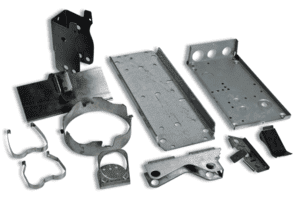At ESI, we have deep industry expertise and a long-standing commitment to helping our clients reduce the cost of stamped metal parts without compromising quality. With over 30 years in the business, we've continuously evolved our engineering and manufacturing capabilities, leveraging the latest automated systems to deliver precision and efficiency. Our experience comes from supplying critical components for the automotive sector—where quality, speed, and performance are non-negotiable.
If you're looking to cut costs on your stamped metal parts, there are several key areas you can examine and optimize. Here are three important factors that can make a big difference:
Material Selection
The choice of material plays a crucial role in the cost of metal stamping. Even small changes in material properties can significantly impact production time and cost. For example, harder materials require more energy and time to stamp, increasing overall expenses. However, switching to a softer or less abrasive material—without sacrificing the required strength or durability—can lead to substantial savings. In some cases, alternative materials offer similar performance at a lower price point, making them an attractive option.
It's also worth considering how market conditions affect material pricing. If your original design used a specific material due to its unique characteristics, but the minimum requirements for the part have since changed, you may be able to switch to a more cost-effective option without any loss in quality or functionality.
Tooling Design and Maintenance
Tooling is another major factor in the cost of metal stamping. The complexity of your tooling directly affects both production time and cost. For instance, square holes typically require more machining than round ones, leading to higher tooling and labor expenses. By simplifying your design where possible, you can reduce the need for complex tooling, which in turn lowers costs and improves efficiency.
Additionally, reviewing your tooling for features that cause wear or frequent repairs can help you avoid unnecessary downtime. Complex notches or sharp edges often lead to increased wear on stamping dies, which can result in cracks or failure if not properly maintained. If such features are necessary, implementing a more rigorous maintenance schedule can extend die life and reduce long-term costs.
Production Volume and Planning
When demand increases, it’s essential to plan for larger production runs. Higher volumes allow for better optimization of designs, improving manufacturability and reducing per-unit costs. If you're working with prototype designs, now is the time to look for opportunities to simplify or modify components while still meeting functional requirements.
Material and finishing costs can vary widely based on volume. Placing blanket orders over a set period with smaller, regular shipments can lead to better pricing and more predictable supply chains. Reviewing your design for complex features also helps improve quality control and reduces the frequency of tooling maintenance.
Understanding your Estimated Annual Usage (EAU) is vital. Depending on how often you produce parts, different tooling options—such as multi-cavity tools or specialized coatings—may offer cost savings without affecting performance. Adjusting the material thickness or switching to a more malleable metal can also increase die life and reduce material costs.
In cases where production volume exceeds expectations, you may need additional tooling to meet demand. Sharing your projected volume early with your supplier ensures that they can plan accordingly and avoid costly delays or extra charges.
Quality and Cost-Effective Metal Stamping Services
Reducing the cost of stamped metal parts doesn’t mean sacrificing quality. By carefully reviewing your material choices, tooling needs, and production volume, you can achieve significant savings while maintaining high standards. At ESI, we specialize in providing engineering and manufacturing solutions that balance cost-effectiveness with precision and reliability.
We work closely with our clients throughout the entire process to ensure that their stamped parts meet both their functional needs and industry requirements. Whether you're looking to optimize your current design or explore new manufacturing strategies, we’re here to help. Contact the ESI team today and request a custom quote tailored to your specific needs.
Vacuum forming is a manufacturing process used to create car parts by heating a plastic sheet and then stretching it over a mold using vacuum pressure.
You may probably find the automotive industry is the most made by vacuum forming,both for comsumer and commercial vehicles,trucks, and buses.Usually the vacuum forming car parts contain:Front bumper, rear bumper, ceiling, roof luggage compartment, wheel arches, doors, tailgate padding, dashboard, fenders, car logo, and interior and exterior plastic decorations.
In addition, the plastic trays which are used for the transportation of the engine block and cylinder also was made by vacuum forming.
Vacuum Forming Car Parts,Vacuum Forming Auto Parts,Thermoforming Car Parts,Thermoforming Auto Carts
Dongguan Yiyongli Industrial Co.,Ltd. , https://www.absthermoforming.com

Comments are closed